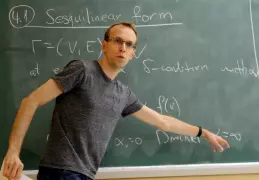– Europe/Lisbon
Room P4.35, Mathematics Building — Online

The dry ten Martini problem for Sturmian Schrödinger operators
"Are all gaps there?", asked Mark Kac in 1981 during a talk at the AMS annual meeting, and offered ten Martinis for the answer.
This led Barry Simon to coin the names the Ten Martini Problem (TMP) and the Dry Ten Martini Problem for two related problems concerning the Almost-Mathieu operator.
The TMP is about showing that the spectrum of the Almost-Mathieu operator is a Cantor set. The Dry TMP is about the values that the integrated density of states (IDS) attains at the spectral gaps. The gap labelling theorem predicts the possible set of values which the IDS may attain at the spectral gaps. The Dry TMP is whether or not all these values are attained, or equivalently, "are all gaps there?". The TMP was fully solved by Artur Avila and Svetlana Jitomirskaya in 2005.
Artur Avila, Jiangong You and Qi Zhou posted this year a preprint with the solution of the Dry TMP for the non-critical case (the coupling constant of the potential differs from one).
This talk is about the Dry TMP for Sturmian Schrödinger operators. These are one-dimensional Schrödinger operators with aperiodic potentials which are Sturmian sequences. The potential is determined in terms of two parameters: the frequency and the potential strength (a.k.a coupling constant). As for the Almost-Mathieu operator the Dry TMP is whether all the possible spectral gaps are there for all irrational frequencies and all values of the coupling constant. For large values of the coupling constant, the Sturmian Dry TMP was solved by Laurent Raymond in 1995. In 2016, David Damanik, Anton Gorodetski and William Yessen provided a solution if the frequency is the golden mean and for all couplings.
We present our current work, jointly with Siegfried Beckus and Raphael Loewy, where we solve the Sturmian Dry TMP for all irrational frequencies and all couplings.